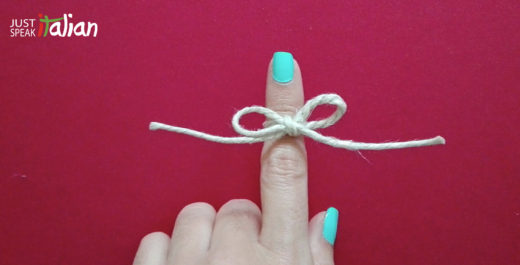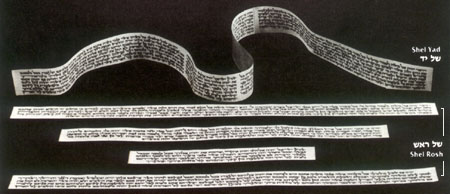02 Dec
- By Liliana Giovenco
- In Italian Language
- Comments None

Come hai probabilmente notato, in Italia usiamo molti modi di dire, a volte anche scherzosamente.
As you have probably noticed, in Italy we use a lot of sayings, sometimes in a laughing way.
Se hai degli amici italiani o hai vissuto a contatto con loro, hai forse sentito l’espressione “Questa me la lego al dito!” riferita ad un torto o ad un’offesa che non si può dimenticare. La maggior parte delle volte io stessa uso questa espressione proprio con i miei amici in tono di scherzo.
If you have got Italian friends or you have lived in a close contact with them, you might have heard the expression “Questa me la lego al dito!” referred to an injustice or an offense hard to forget. Most of the times I use myself this expression even with my friends in a joking tone.
“Legarsela al dito” è un modo di dire molto antico e troviamo dei riferimenti addirittura nella Bibbia (Esodo, XIII, 9 e 16; Deuteronomio, VI, 8, XI, 18) e nel Vangelo di Matteo (XXIII, 5), dove si parla di portare in mano un oggetto per non dimenticare una cosa.
“Legarsela al dito” is a very old saying and we find references even in the Bible (Exodus, XIII, 9 and 16; Deuteronomy, VI, 8, XI, 18) and in the Gospel of Saint Matthew (XXIII, 5), where it is mentioned about holding in hands an object not to forget something.
L’origine dell’espressione è collegata all’antica usanza di mettersi un segno, come un fazzoletto annodato al dito, per ricordare qualcosa. Gli Ebrei, ad esempio, appendevano al collo la mezuzah, un oggetto che racchiudeva una pergamena dove erano inscritti alcuni versi della Torah e legavano inoltre alle braccia altre strisce di pergamena, chiamate “filatteri”, con alcuni passi della Bibbia.
The origin of the expression is connected to the old habit of wearing a sign, like a handkerchief knotted around a finger, to recall something. The Jewish people, for example, used to wear around their neck the mezuzah, an object containing a piece of parchment inscribed with verses from the Torah. They also tied around their arms strips of parchment, called “phylacteries”, with some passages of the Bible.
A questa pratica di legare qualcosa attorno alle parti del corpo come promemoria è collegata la nascita dell’anello di fidanzamento! In Turchia, infatti, il cavaliere legava un filo d’oro attorno al dito della propria dama prima di partire per la guerra: in questo modo lei guardandolo si sarebbe ricordata di lui. In seguito il filo si è trasformato in anello che è diventato il simbolo della promessa del legame fra un uomo e una donna.
The origin of the engagement ring is connected to this practice of tying something around parts of the body as a reminder! In Turkey, actually, the knight used to knot a golden thread around his lady’s finger before leaving for war: this way she could look at it and remember him. Then the thread turned into a ring becoming the symbol of the promise of the bond between a man and a woman.
È facile adesso capire come “legarsela al dito” oggi significhi non dimenticare qualcosa, anche se nel tempo questa espressione ha acquisito una connotazione negativa (portare rancore verso qualcuno).
It is easy now to understand how, nowadays, “legarsela al dito” means do not forget something, even if along the centuries this expression has acquired a negative connotation (to bear a grudge against somebody).
Le dita, come altre parti del corpo, sono molto frequenti nei modi di dire italiani. Scopriamone qualche altro con questa parola!
Like other parts of the body, fingers are very frequent in Italian sayings. Let’s discover more expressions with this word!
“Nascondersi dietro un dito” – “You can’t hide behind that!”
Trovare scuse poco credibili, negare l’evidenza – To find excuses that are hard to believe, to deny the evidence of facts
“Dare un dito e farsi prendere il braccio” – “Give him an inch, and he will take a yard”
Approfittare eccessivamente della disponibilità di qualcuno – To take too much advantage of someone’s kindness
“Contarsi sulle dita di una mano” – “You can count them on the fingers of one hand”
Essere in numero così basso che basterebbero le dita di una mano per contarle – To be so few in number that the fingers of one hand could be enough to count them
“Non muovere un dito” – “Not to lift a finger”
Non fare nulla, soprattutto in contrapposizione a qualcuno che invece fa molto – Not to do anything especially if compared to someone who does a lot
“Leccarsi le dita” – “To lick one’s fingers”
Trovare un cibo molto gustoso; metaforicamente si usa anche per una situazione che sembra molto vantaggiosa – To find a meal delicious; metaphorically it is used to mean a situation that looks convenient
“Mordersi/mangiarsi le dita” – “To kick oneself”
Pentirsi di non aver agito in un determinato modo avendo così perso una buona occasione – To regret not having behaved in a particular way lmissing a good opportunity
“Mettere il dito nella piaga” – “To rub salt in the wound”
Non avere pietà quando c’è una situazione problematica – To be pitiless when it comes to a difficult situation
Recent Posts
Archives
- April 2021
- February 2021
- November 2020
- February 2019
- November 2018
- August 2018
- May 2018
- March 2018
- February 2018
- January 2018
- December 2017
- November 2017
- October 2017
- August 2017
- July 2017
- June 2017
- April 2017
- March 2017
- February 2017
- January 2017
- December 2016
- October 2016
- August 2016
- July 2016
- June 2016
- May 2016
- April 2016
- March 2016
- February 2016
- January 2016
- December 2015
- November 2015
- October 2015
- September 2015
- August 2015
- July 2015
- January 2015


